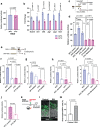Temperature sensitivity of Notch signaling underlies species-specific developmental plasticity and robustness in amniote brains
- PMID: 35013223
- PMCID: PMC8748702
- DOI: 10.1038/s41467-021-27707-5
Temperature sensitivity of Notch signaling underlies species-specific developmental plasticity and robustness in amniote brains
Abstract
Ambient temperature significantly affects developmental timing in animals. The temperature sensitivity of embryogenesis is generally believed to be a consequence of the thermal dependency of cellular metabolism. However, the adaptive molecular mechanisms that respond to variations in temperature remain unclear. Here, we report species-specific thermal sensitivity of Notch signaling in the developing amniote brain. Transient hypothermic conditions increase canonical Notch activity and reduce neurogenesis in chick neural progenitors. Increased biosynthesis of phosphatidylethanolamine, a major glycerophospholipid components of the plasma membrane, mediates hypothermia-induced Notch activation. Furthermore, the species-specific thermal dependency of Notch signaling is associated with developmental robustness to altered Notch signaling. Our results reveal unique regulatory mechanisms for temperature-dependent neurogenic potentials that underlie developmental and evolutionary adaptations to a range of ambient temperatures in amniotes.
© 2022. The Author(s).
Conflict of interest statement
The authors declare no competing interests.
Figures






Similar articles
-
Cigarette smoke upregulates Notch-1 signaling pathway and promotes lung adenocarcinoma progression.Toxicol Lett. 2022 Feb 1;355:31-40. doi: 10.1016/j.toxlet.2021.11.002. Epub 2021 Nov 5. Toxicol Lett. 2022. PMID: 34748854
-
Role of the Notch Signaling Pathway in Fibrosis of Denervated Skeletal Muscle.Curr Med Sci. 2019 Jun;39(3):419-425. doi: 10.1007/s11596-019-2053-z. Epub 2019 Jun 17. Curr Med Sci. 2019. PMID: 31209813
-
Conserved and divergent functions of Pax6 underlie species-specific neurogenic patterns in the developing amniote brain.Development. 2018 Apr 16;145(8):dev159764. doi: 10.1242/dev.159764. Development. 2018. PMID: 29661783 Free PMC article.
-
Role of CSL-dependent and independent Notch signaling pathways in cell apoptosis.Apoptosis. 2016 Jan;21(1):1-12. doi: 10.1007/s10495-015-1188-z. Apoptosis. 2016. PMID: 26496776 Review.
-
Notch, neural stem cells, and brain tumors.Cold Spring Harb Symp Quant Biol. 2008;73:367-75. doi: 10.1101/sqb.2008.73.013. Epub 2008 Nov 6. Cold Spring Harb Symp Quant Biol. 2008. PMID: 19022772 Free PMC article. Review.
Cited by
-
Neural differentiation in perspective: mitochondria as early programmers.Front Neurosci. 2025 Jan 8;18:1529855. doi: 10.3389/fnins.2024.1529855. eCollection 2024. Front Neurosci. 2025. PMID: 39844856 Free PMC article. Review.
-
Notch1 Phase Separation Coupled Percolation facilitates target gene expression and enhancer looping.bioRxiv [Preprint]. 2024 Aug 1:2023.03.17.533124. doi: 10.1101/2023.03.17.533124. bioRxiv. 2024. Update in: Sci Rep. 2024 Sep 19;14(1):21912. doi: 10.1038/s41598-024-71634-6. PMID: 39131356 Free PMC article. Updated. Preprint.
-
Regulation of immune cell development, differentiation and function by stromal Notch ligands.Curr Opin Cell Biol. 2023 Dec;85:102256. doi: 10.1016/j.ceb.2023.102256. Epub 2023 Oct 6. Curr Opin Cell Biol. 2023. PMID: 37806295 Free PMC article. Review.
-
Oscillatory DeltaC Expression in Neural Progenitors Primes the Prototype of Forebrain Development.Mol Neurobiol. 2025 Apr;62(4):4076-4092. doi: 10.1007/s12035-024-04530-9. Epub 2024 Oct 11. Mol Neurobiol. 2025. PMID: 39392541 Free PMC article.
-
Notch1 Phase Separation Coupled Percolation facilitates target gene expression and enhancer looping.Sci Rep. 2024 Sep 19;14(1):21912. doi: 10.1038/s41598-024-71634-6. Sci Rep. 2024. PMID: 39300145 Free PMC article.
References
-
- Schmalhausen I. I. Factors of evolution: the theory of stabilizing selection. (The Blakiston Company, 1949).
-
- Waddington CH. Selection of the genetic basis for an acquired character. Nature. 1952;169:625–626. - PubMed
-
- Beldade P, Koops K, Brakefield PM. Developmental constraints versus flexibility in morphological evolution. Nature. 2002;416:844–847. - PubMed
-
- Gilbert S. F. Ecological developmental biology. (Sinauer Associates, 2015).
Publication types
MeSH terms
Substances
LinkOut - more resources
Full Text Sources
Research Materials

